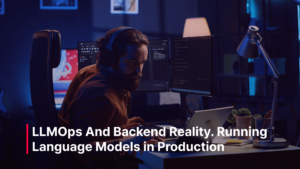LLMOps and backend not that often associated, and if you’ve spent any time around large language models this year, you’ve likely experienced both the awe and the friction. It’s one thing to spin up a GPT-powered chatbot over the weekend. It’s another to run a language model reliably in production, at scale, under latency constraints, and with actual users expecting useful, safe, and fast results.
This is where things get messy. For backend teams, integrating LLMs into modern software stacks introduces a new set of operational challenges, ones that feel familiar in some ways (rate limits, scaling, observability) but completely new in others (prompt design, hallucination control, retrieval pipelines). That’s the essence of LLMOps and backend: the intersection of backend architecture, ML infrastructure, and generative AI behavior.
Why LLMOps Isn’t MLOps With Bigger GPUs
Traditional machine learning in production is largely deterministic. You train a model on labeled data, expose it through a REST API, and maybe retrain it once a month with fresh inputs. With LLMs, everything changes.
First, the “model” is a massive transformer architecture with context windows, prompt formatting rules, inference parameters, and token-based billing models. The prompt becomes your API contract, latency becomes probabilistic, and every response carries the risk of hallucination.
The scale of these models, often requiring specialized GPU hardware or access to hosted APIs means that backend teams are now part infrastructure engineer, part prompt architect, and part product strategist.
From Proof of Concept to Production: The Backend Shift
In the early days, teams tend to move fast: hardcode a prompt, call OpenAI’s API, and return a response. But once you move beyond a simple chatbot or content generator, backend realities hit hard.
Inference is not plug-and-play. Whether you’re using a hosted model or deploying one on your own infrastructure, you’ll quickly run into issues around autoscaling, GPU memory limits, and latency spikes. In some cases, loading a model and generating an output might take seconds, which is unacceptable in user-facing flows.
Latency is spiky. LLMs don’t behave like typical APIs. Inference time scales with both input length and output length, and response generation is typically token-by-token. That means a minor change in the prompt can result in wildly different response times. You’ll need to implement caching, timeout controls, and possibly even streamed outputs (via SSE or WebSockets) to handle real-world expectations.
Prompts become part of your backend logic. Hardcoded prompts don’t scale. As your application grows, you’ll need a system to manage prompt templates, run A/B tests, inject context dynamically, and roll back changes without pushing code. Some teams use prompt management platforms; others roll their own systems with versioning and observability baked in.
A New Stack for a New Paradigm
To build reliable, context-aware LLM applications, backend teams are starting to converge on a new kind of architecture that blends traditional infra principles with AI-native workflows.
At the core is your inference layer. This could be an external API like OpenAI, Anthropic, or Mistral via third-party providers. Or it could be self-hosted using frameworks like vLLM or Text Generation Inference (TGI), depending on your control, latency, and compliance needs.
Surrounding that is your context engine, aka the logic that dynamically builds prompts using user history, documents, metadata, and environment variables. This is especially important in retrieval-augmented generation (RAG) pipelines, where relevant context is fetched from a vector database and injected into the prompt.
You’ll also need observability tailored for LLMs. Traditional logging won’t cut it. You’ll want to track token usage, prompt/output diffs, latency variance, and error types (timeouts, rate limits, null completions). Tools like Langfuse, Helicone, or homegrown dashboards are increasingly common.
Don’t forget guardrails to validate or sanitize outputs before they reach users. These can flag hallucinations, remove toxic language, or trigger fallback behavior. And speaking of fallbacks, always plan for graceful degradation: shorter prompts, cached responses, simpler models, or human-in-the-loop systems when things go sideways.
Hosted vs. Self-Hosted: Cost, Latency, and Control
One of the most strategic decisions backend teams face is whether to use hosted LLM APIs or deploy models in-house.
Hosted models (like GPT-4, Claude, or Gemini) offer speed, convenience, and continuous improvements. But they come with trade-offs: limited control, high per-token costs, and the need to send data outside your infrastructure, which can raise concerns in regulated industries or IP-sensitive environments.
Self-hosted models (like Mistral, LLaMA, or Mixtral variants) give you complete control and can be optimized for cost at scale, especially when running high-throughput tasks. But you’ll need to manage GPU allocation, model loading, scaling logic, and observability, adding considerable backend complexity.
In practice, many teams adopt a hybrid model: start with hosted APIs for rapid prototyping, then migrate high-volume, latency-critical, or sensitive workloads to self-hosted infrastructure as usage patterns stabilize.
Tools That Make LLMOps and Backend Doable
The LLMOps ecosystem is maturing rapidly. Depending on your needs, here are a few tools we’ve seen used effectively in production:
- LangChain / LlamaIndex for building RAG pipelines and context-aware agents
- PromptLayer / HoneyHive for tracking and managing prompt iterations
- Langfuse / Helicone for observability, logging, and cost monitoring
- GuardrailsAI / Rebuff for output validation and content safety
- vLLM / TGI for high-performance model inference at scale
- Modal / Replicate / RunPod for flexible GPU infrastructure
While no tool is perfect, investing in even a basic LLMOps stack pays off quickly, especially when you’re dealing with unpredictable behavior or growing costs.
Backend Teams Are the Bridge
There’s a misconception that running LLMs in production is exclusively an ML or frontend problem. It’s not. The backend is where everything comes together: context aggregation, prompt logic, system reliability, inference performance, and cost control.
LLMOps and backend juxtaposition requires creating a predictable, observable, and scalable system around inherently unpredictable technology. And as these models become embedded in more core workflows, from internal search to customer support to developer tooling, backend teams will be the ones who determine whether GenAI features are delightful or disastrous.
So yes, the hype is real, but the operational lift is even more real. And for those who figure it out, the payoff is immense.


